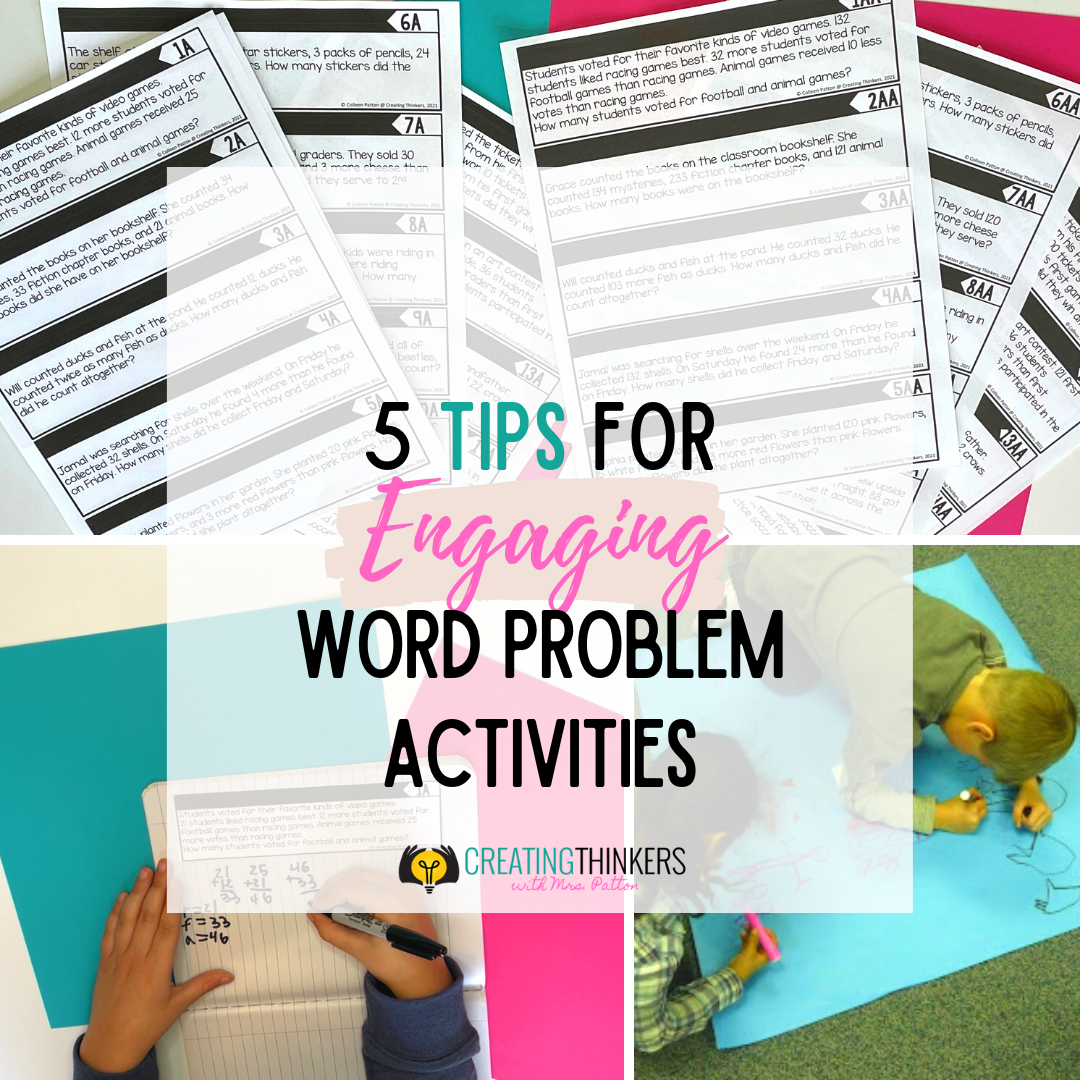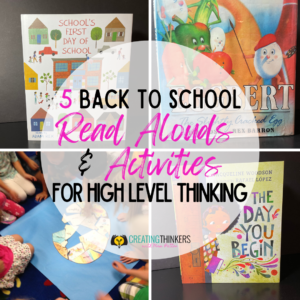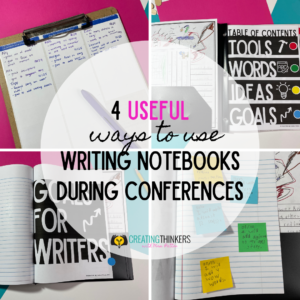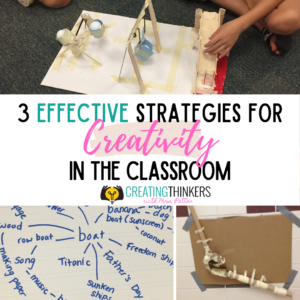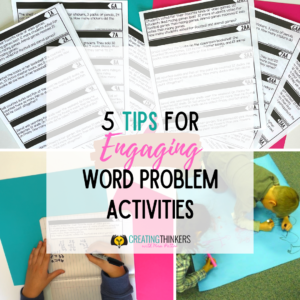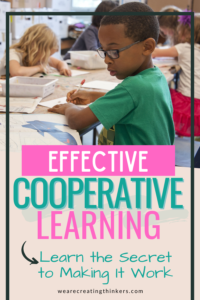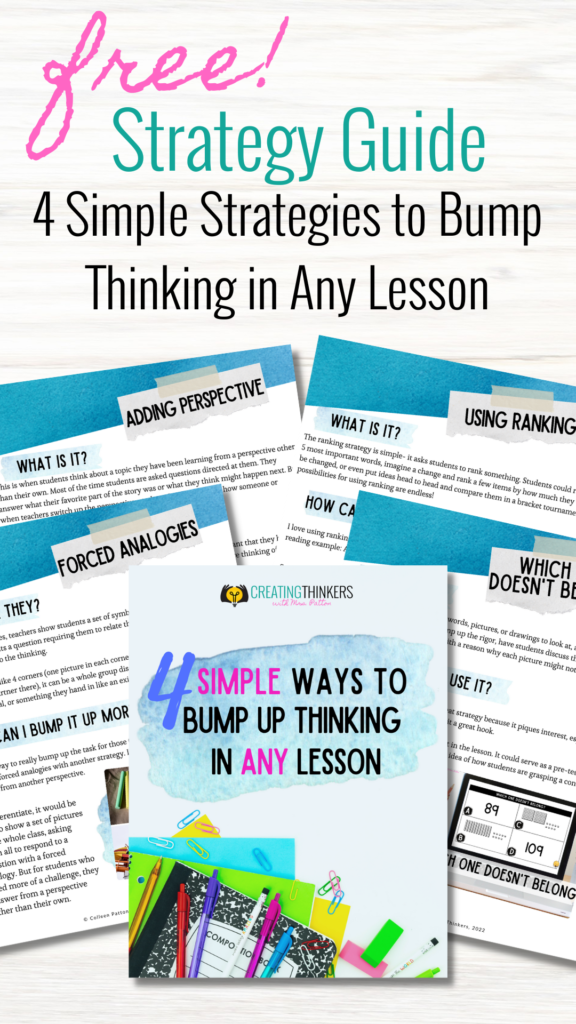So, you want to use word problems in math class, but you aren’t sure of the best way to do this? Maybe you’ve been using them for more years than you can count, and you and your students long for something fresh?
I’m not here to teach you an acronym with the steps for analyzing a problem. If your students need that, a quick Google search will give you millions of results! BUT I am here to show you some examples of word problems in math class that you might not have thought of. Some tips are oh so simple, yet might be just enough different to make your students wonder what you’re up to!
Word Problems… Without the Numbers!
If you want to see what kind of mathematical thinkers you have in your classroom, or just want to help your students SLOW DOWN, you should give numberless word problems a try.
In essence, numberless word problems temporarily remove the numbers so students can think about the situation without that distraction. If you’re wondering how to break down word problems in math, this is it!
It is truly one of my favorite ways to get kids thinking and talking about word problems- something that isn’t always that easy to do. Sometimes I use a numberless problem to warm-up before we begin.
Here are the steps for trying out numberless word problems:
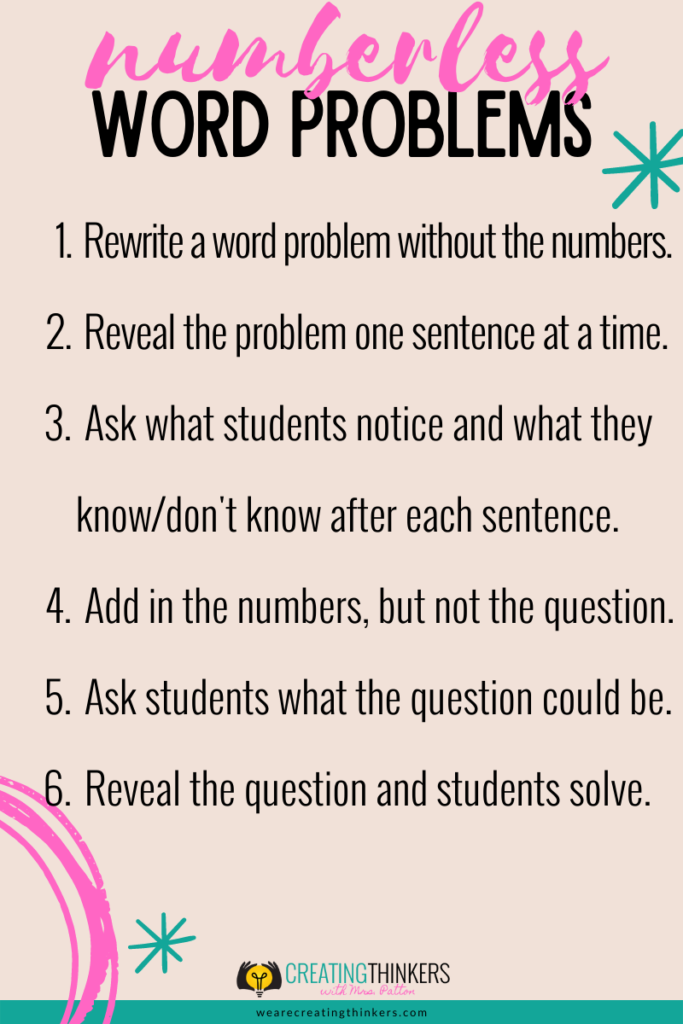
In my experience, the most important thing is to take the problem one sentence at a time and ask questions like “What do you notice?” or “What do we know/not know?” or at the end “What questions could we ask?”
With the right amount of wait time, turn and talk, and practice, even your reluctant math students will be willing to take risks in their thinking!
Here’s a numberless word problem freebie for you… use this Google Slideshow to give numberless word problems a try!
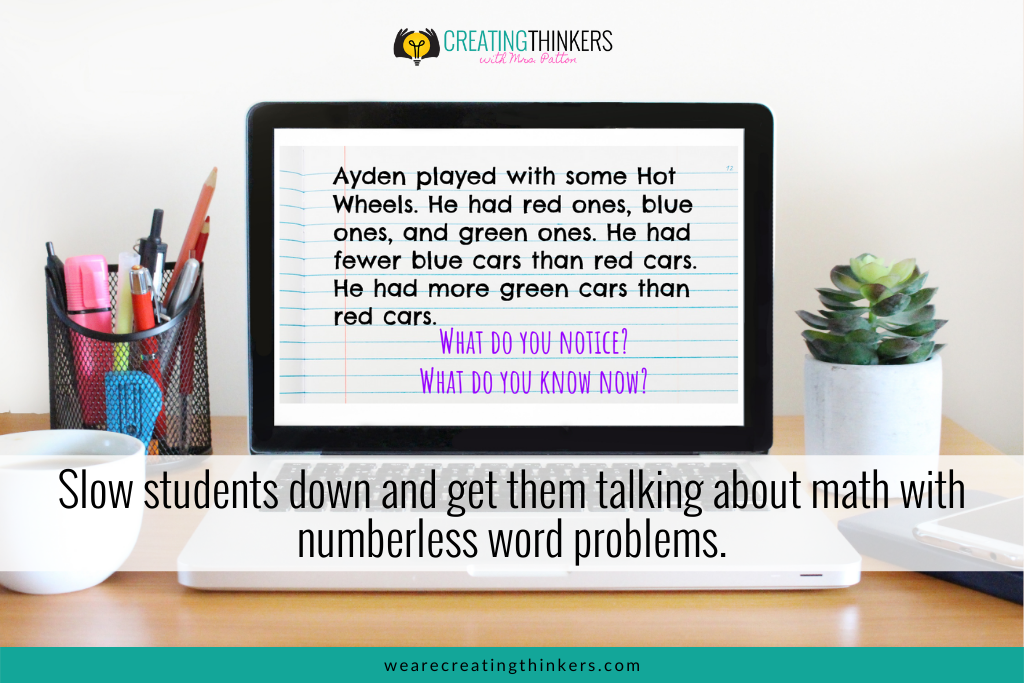
If you’d like some more specific information, you may enjoy this article as well.
Collaborative Word Problem Strategies
For students who struggle with how to understand word problems in math, collaborative problem solving might be the answer.
For years, I have switched things up and let my students solve problems on a large piece of butcher paper on the floor. To top it off, I have them use those amazing smelly markers that are typically just for the teacher. There’s something about working with a smelly marker on a large paper that makes problem solving interesting enough to pull in that reluctant student.
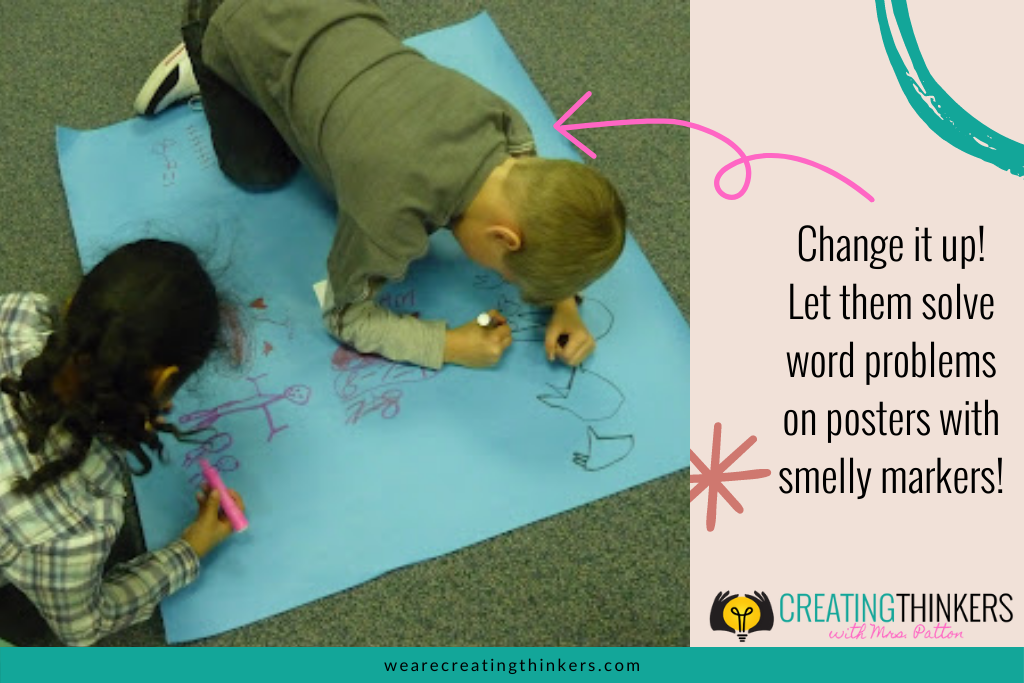
When I’ve used this strategy, I set out several pieces of butcher paper with a copy of the word problem glued to the top or middle of each paper. *I would suggest you keep some extra copies nearby in case students struggle to read the problem well when another person is there with them* Students write all around the paper to show how they solved the problem.
The best part about this is students can see others’ strategies and give them a try if they don’t know where to start. Then, at the end it’s a great talking piece. You can easily look at the strategies and talk about the most efficient ones as well as multiple ways to solve the problem.
If you’re looking for a digital option, you might enjoy the idea of using a collaborative Google Slides presentation. Students can still solve the problem in their math journals, but when they are done they take a picture of their work and add it to their slide in the slideshow.
Just like with the butcher paper examples, this is a great tool to look at as a class and analyze the effectiveness of different strategies students used. Plus, it may give them motivation to show their work and prove their thinking in hopes that you may point out something on their slides.
Give Them the Answers!
Did that heading make you stop in your teacher tracks??? Yup, you read it right… give them the answers! Now let me explain what I mean here…
One of the most impactful changes I have made in assigning word problems is giving students an answer bank with correct answers. In fact, I’ve used this for several math activities when students are solving task cards.
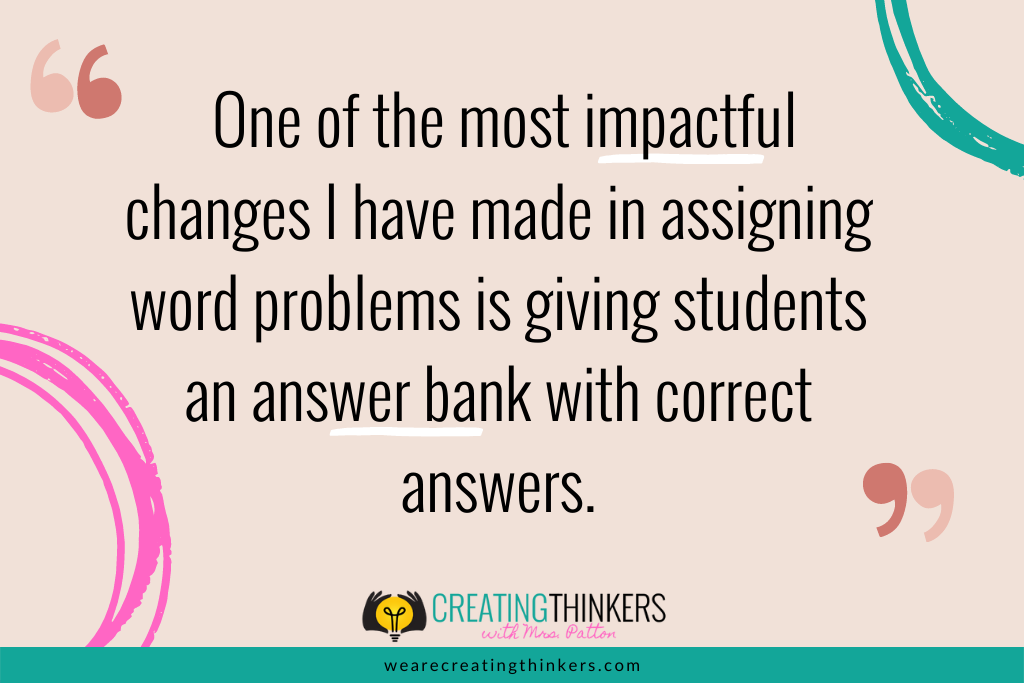
I don’t tell students which problem goes with each answer, but I do provide a list of correct answers for the problems they will solve. I usually just type them in a table on a blank Google Slides presentation and show it on our screen.
What I’ve found is that it takes the pressure down a notch. It also sends the message that I really do value the process and thinking over the correct answer. Also, since I already provided the answers, students can no longer write only an answer without showing their work!
Another added benefit is the grading aspect. When students look for the answer they found, but do not see it in my answer bank they begin self-reflecting. I’ve seen several students find their own mistakes or know to ask for help since they got this immediate feedback. It is much more powerful than having students wait for the time it takes me to get a chance to grade it and THEN go back and rework it.
I highly suggest that you give answer banks a try! Seriously, this is probably my favorite of these tips for word problems in math!
Add Some Word Problem Movement
Anytime I can find a way to get out some of that 2nd grade energy, I take it. And my students always appreciate the opportunity! One of our favorite ways to get moving in my math workshop is “scoot.”
To do a scoot, you would place the word problems you want students to solve around the room. Students walk around from problem to problem with a recording sheet “scooting” to each problem to solve it. You can do it all at once with a signal to move, or students can move at their own pace.
In my room, students work with a partner or by themselves and are responsible for finishing the scoot at some point during the week. This way students can move at their own pace and avoid wasted wait time.
You can make a scoot from a set of word problems placed around the room, a worksheet where you cut apart the problems and tape them around the room, or with a set of task cards.
I LOVE that you can just cut apart a worksheet to make a scoot. I remember a time or two when I saw some squirrely kids and shocked them when I said, “You know what, we are going to change this up” as I started cutting apart their assignment. There’s nothing quite like shocking your students to get them engaged in learning!
Since this has been a favorite activity in my room, I have several scoots I’ve made for my classroom. I don’t usually start cutting apart worksheets! Check these out if you’re interested:
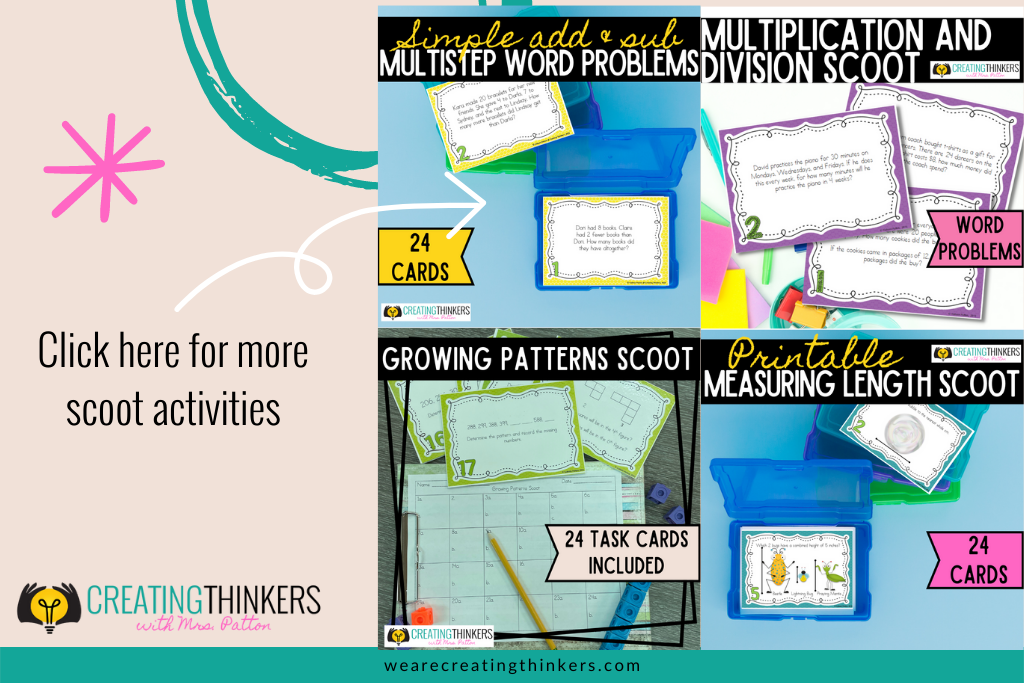
Differentiating Word Problems
I am not a teacher who stands by as students fly through math work that is far too easy. I strongly believe that every student deserves to learn and grow, no matter how much they already know!
Typically, I have at least two levels of word problems in my room happening at the same time. I’ve tried many ways to organize differentiated work, but have settled on a Must Do May Do format coupled with a good ol’ plastic bag.
As you can see in the video below, I put word problem strips in bags labeled with student names. Then, they take the appropriate one and solve it in their math journals.
I used to spend so many hours creating differentiated word problems for my students. But now I’ve organized them and made multiple versions so I can easily pick and choose. If you would love to use differentiated word problems that elicit higher level thinking, but lack time to make them… look no further! The problems I used in the video above were a labor of love that I now can share with you!
I made 100 multi step word problems with and without regrouping in two different versions. It has a 2-digit and a 3-digit version totaling 200 problems! Grab your copy below!
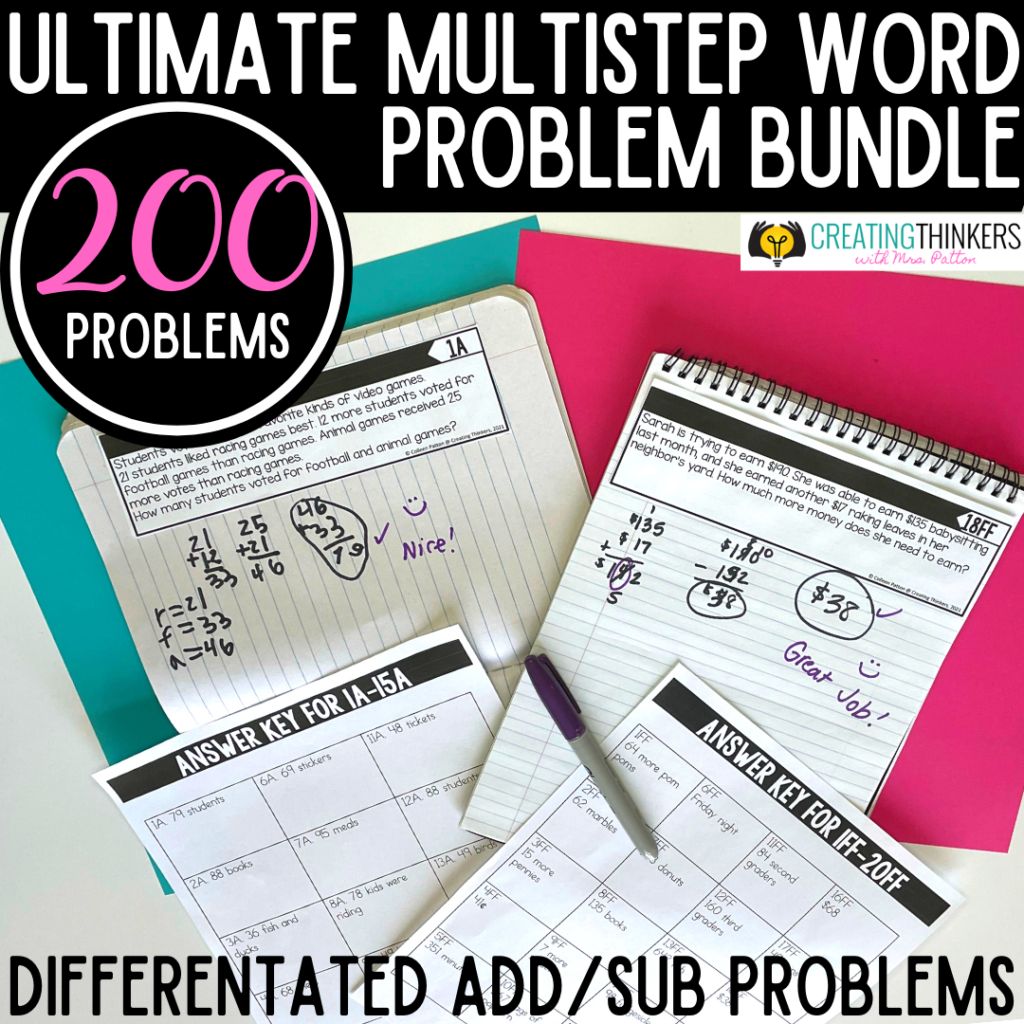
Looking to learn more about differentiating your math instruction? Check out this post.
Interested in starting your math block with some great warm-ups? Check out this post.

Let Me Help You Turn Your Students into Thinkers!
If you have a passion for getting your kids to think, you’ll love my FREE Guide. It’s about 4 simple strategies to bump up the thinking in any lesson. Download it for free and stay in touch to get classroom-tested ideas straight to your inbox!
Keep those kids thinking!
Colleen Patton
Note: Some of the links in this post are affiliate links. I may get a small commission if you purchase these, but hey that helps me keep offering some awesome freebies for you!

